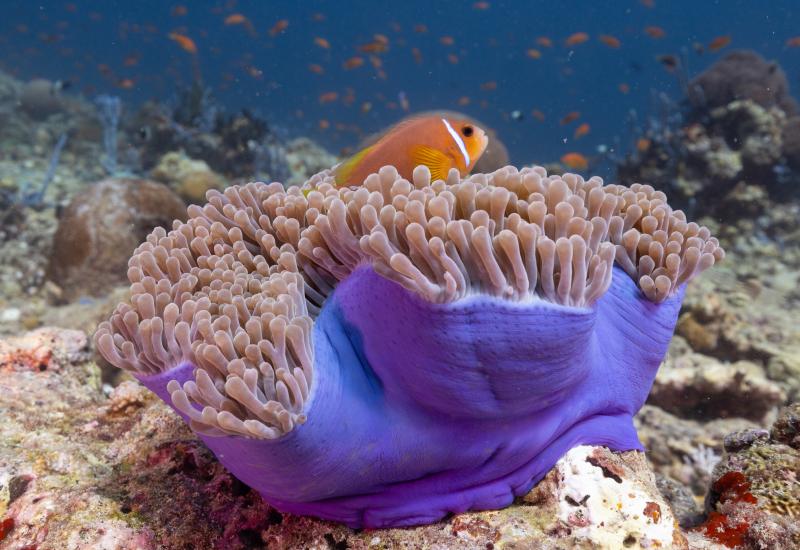Conservation Spotlight: Manta Trust
MISSION: “To conserve mobulid rays, their relatives, and their habitats, through a combination of research, education and collaboration.”
YEAR STARTED: 2011
CONNECT: Instagram | Facebook | Twitter
PROJECT: Manta encounters are at the top of almost every diver’s bucket list. With so much popularity, you might think biologists have done tons of research to figure them out, but in fact, there is much still unknown about these animals. Manta Trust’s diverse team of scientists, conservationists, educators and media experts is working to fill in the gaps.

Dr. Guy Stevens / Manta TrustThe Maldives is home to the world's largest population of reef manta rays offering the Manta Trust team and incredible opportunity to research them.
“At our main project base in the Maldives, we are collecting population demographic data through photo IDing,” says Simon Hilbourne, media and communications manager for Manta Trust.
Mantas have unique spot patterns on their undersides, which researchers use to catalog sightings of each individual. By noting the location and time of each sighting over the years, they have built a clear picture of migration patterns. They’ve also collected tourism data to determine the impact and stress of tourism on rays, and they look at environmental conditions like currents, tides and food availability to try and understand why mantas migrate when and where they do.
All of this, and research conducted by affiliate projects worldwide, has led Manta Trust to positively impact mantas and their habitats, from ensuring their status on the IUCN Red List to securing international protective legislation to creating Marine Protected Areas.
“Manta rays are an enigmatic species that people can easily fall in love with. Therefore, they are a great species to use to protect entire habitats and ecosystems,” says Hilbourne. “Through Marine Protected Areas, we can protect not just the manta rays that feed or clean there, but all the other species of fish as well.”
Because of mantas’ high age of sexual maturity (10 to 15 years old) and low birth rates (one every five to seven years), manta populations are slow to grow, and they’re ultra-susceptible to decline as a result of the many threats they face, the biggest of which, Hilbourne says, is fisheries.
“Be it targeted fisheries, accidental bycatch from tuna fisheries, or just entanglement in fishing nets, mantas are being killed in large numbers in much of their natural range around the world,” he says. “The demand for mobula gill plates in Chinese medicine drives the targeted fishery, but many individuals are accidentally caught or entangled, and the outcome is the same.”
Highlighting the issues around the gill-plate industry can also have ripple effects on other urgent issues, like shark finning and the illegal wildlife trade for traditional medicines.

Simon Hilbourne / Manta TrustA Manta Trust researcher comes face to face with a curious reef manta ray (Mobula alfredi) in the Maldives.
GET INVOLVED
1. Adopt a Manta
For a one-time donation to Manta Trust, you can symbolically adopt a real manta. With your adoption, you’ll receive your manta’s bio, a fact file, a kids’ activity pack, a poster and a personalized adoption certificate.
“The four individuals we currently have up for adoption are mantas that we have known for a while and have a great personality and/or a back story,” Hilbourne says. “For example, Babaganoush is one of our favorite manta rays in Baa Atoll, however he was struck by a speed boat and suffered severe injuries.” (See his story here.)
Manta adoption is a great way to connect with these animals and learn more about them while supporting a global effort to conserve them. They also make great gifts!
2. Submit your Manta photos for ID
To expand their research, Manta Trust calls on the millions of divers who see mantas around the world every day. Follow Manta ID guidelines when diving, and submit your photos to the database. Manta Trust will then contact you with whatever information they have about your individual, including gender, number of sightings and pregnancies. If it is a new manta, you’ll get to name it!
There have been some awesome connections made with ID submissions, including Hilbourne’s story of Ewok:
“A very common manta ray in Baa Atoll, Ewok, stopped appearing one year. The team thought perhaps they just hadn't snapped a photo of her, however, another year passed with still no sighting. And then another. The team were worried she'd maybe died naturally or as a result of humans. Finally, a couple of years later, a diver in Addu, some 650km further south, submitted a photo to us. It was Ewok! She was alive and well, and what's more, she was now pregnant!”
“We like to think she found love and moved down south,” Hilbourne jokes. In reality, they have no idea why Ewok made such a migration — it’s just another mystery of mantas.
3. Join The Cyclone
By making a recurring monthly or annual donation, you can become part of The Cyclone, Manta Trust’s inner circle.
“The Cyclone was created to make a portal for us to connect with our most passionate and supportive followers,” Hilbourne says. “It is our way of saying thank you to those who have, and continue to, support the Manta Trust and the work we do.”
Members of The Cyclone get access to exclusive content, behind-the-scenes clips, team interviews and perks like exclusive store discounts and occasional free manta adoptions, so you can stay engaged with manta conservation and be included in Manta Trust’s latest work year-round.
BONUS: Go on a Manta Expedition
For the ultimate enriching megafauna experience, join a Manta Expedition. On these one- to two-week-long liveaboard trips, divers can get up-close and personal with mantas and other megafauna while participating in hands-on workshops and data collection to contribute to meaningful scientific research while traveling.
On expedition, Manta Trust staff’s daily manta presentations will teach you how to determine gender, look for mating scars, ID cleaner-fish species, observe courtship behavior and more. During specific workshops, divers can use their sightings to learn the ins and outs of the Manta Trust’s ID process and see which mantas they’ve been in the water with.
“The want to protect a species comes from having an understanding and appreciation for the species,” Hilbourne says. “On our Manta Expeditions, guests get this added knowledge and understanding that you don't get from purely diving with manta rays. This greater appreciation and understanding helps instill a passion and desire to protect them.”
Manta Expeditions is a separate entity from Manta Trust, but a portion of proceeds from the expeditions is donated to the nonprofit.










